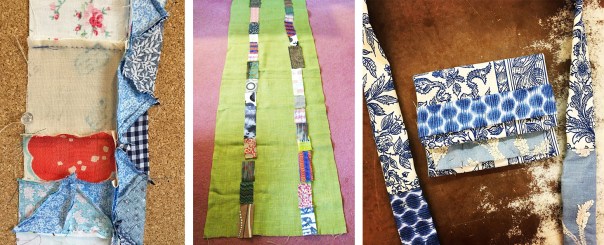
When I’m fortunate to get some time to relax, I like to take a portable art project like hand-sewing outdoors to work on. If I can set myself up by water, that’s even better! Better still to add human companionship by going on a group campout. It’s always nice to take a little break from kayaking and other active pursuits and sit down around a campfire. If I should happen to get stuck with a lot of rainy weather and have to stay under a shelter for awhile, I’ll never be bored waiting it out if I have sewing with me to do. I have more camping trips planned for this season so I’ve prepared some next steps in three different current sewing projects to work on while I’m out there. These are easy to transport rolled up and carried in a bin with a selection of sewing threads and tools.

I’ve readied the right side of Experimental Art Quilt #2 in preparation of adding some accents in blue scrap fabrics and blue thread. The image above shows how I used computer graphics to plan out the red triangle area that I sewed during the last campout. I knew the finishing touches on this were going to either make or break it, so I tested out the red area in Adobe Illustrator first before stitching it. I think after adding the blue area, I’ll go back to the pale yellow areas for a bit of subtle texture, then I think it will be ready for the border to complete it.

Here are some of the scrap strips I made earlier combined with some fabric that is going to frame it in a reverse applique technique. I make a lot of strips of both paper and cloth scraps to incorporate into other projects later. I’m turned on by the idea of one stripe being colorful and rest being all neutrals.


My favorite shirt from the 80s is on the left. It used to be white and black with short sleeves and a collar. Over the years, it got so stained and faded that I stopped wearing it, but I could not bear to get rid of it because I loved the pattern so much. In 2018 I dyed it my favorite color lime green when I had a batch going for my wedding, and last summer I cut the collar and sleeves off and made it into a vest. Now I wear and enjoy it once more!
On the right is that salmon-colored shirt I’ve been stitching on. When I bought this shirt it was white with black. Yes I still love black and white shirts with Aztec-looking designs on them! The first time I wore it, it got stains on it from riding a chartered party van to and from a Rush concert (May 2015 during their farewell tour – EPIC day and night by the way – my brother and his friends started partying at brunch, I joined in a group pre-show BBQ about 3 pm after getting my day’s work done). I don’t know what got on the shirt, but I could never get it out. I put it aside for future dye experiments to try to fix it. I made two different mistakes when dyeing because I was in a hurry and ended up with even more stains and splotches to try to cover up. So I decided to put embroidered patches on all the bad spots until they were all covered up.

Patches on the front are done, though as it gets closer to completion I might add some decorative trim from top to bottom around the center panel to tidy it up. It doesn’t have to be symmetrical, but I think it needs to be a little neater. Now I’m starting work on the back. Sleeves will be last. Although the look is different, the concept of patching clothing with decorative stitching was done very well by the Japanese with the art of Boro, which I would love to try out in the more traditional Japanese manner sometime.
This was a lightweight, airy shirt when I first bought it – now it’s going to be a bit heavier because of the layers, maybe for fall wear. Probably when it gets close to completion I’ll add some white or metallic or both to the yoke area to bring the focus back to the neckline area. In the meantime, I’m having a lot of fun doing the stitching in different weights and colors of thread, like salmon, peach, rust, and coral to see what happens!
























